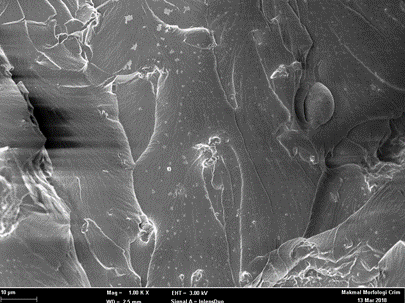
Preparation of Polyurethane Composites with Activated Carbon Black as the Reinforcing Filler
Abstract
The effect of activated carbon black (ACB) on the mechanical properties of palm-based polyurethane composites was studied. Palm-based multi-block polyurethane (PU) was prepared by reacting palm kernel oil-based (PKO-p) monoester with 4,4-diphenyl methane diisocyanate (MDI) through prepolymerization method. Poly(ethylene glycol) (PEG) was used as the chain extender while acetone was used as the solvent to control the reaction kinetics. The amount of ACB added into the PU system was varied at 0 to 8 wt% (percentage by weight). This study aimed to develop a formulation of PU-ACB composite film with excellent mechanical properties. The mechanical characterizations included tensile test, hardness test, and scratch resistance test. Fourier Transform Spectroscopy (FTIR) analysis was also conducted to identify the functional groups present in the PU composites. The incorporation of ACB as filler greatly enhanced the mechanical properties of the PU composites due to compatibility and interfacial adhesion of ACB with PU matrix. The loading of ACB at 8 wt% exhibited the optimum mechanical properties.
Keywords
Full Text:
PDFReferences
Khairiah Haji Badri. 2012. Chapter 20: Biobased Polyurethane From Palm Kernel Oil-Based Polyol. Zafar, F. and Sharmin, E. 2012. Eds. Polyurethanes, ISBN 978-953-51-0726-2, New York: InTech Publication, pp 447-470
Daud FN, Ahmad A, Haji Badri K. An investigation on the properties of palm-based polyurethane solid polymer electrolyte. Int J Polym Sci. 2014;2014: Article ID 326716,
Wong CS, Badri KH. Chemical Analyses of Palm Kernel Oil-Based Polyurethane Prepolymer. Mater Sci Appl [Internet]. 2012;3(2):78–86.
Praveen S, Chattopadhyay PK, Albert P, Dalvi VG, Chakraborty BC, Chattopadhyay S. Synergistic effect of carbon black and nanoclay fillers in styrene butadiene rubber matrix: Development of dual structure. Compos Part A Appl Sci Manuf [Internet]. 2009;40(3):309–316.
Hu Z, Srinivasan MP. Mesoporous high-surface-area activated carbon. Microporous Mesoporous Mater. 2001;43(3):267–275.
Adinata D, Wan Daud WMA, Aroua MK. Preparation and characterization of activated carbon from palm shell by chemical activation with K2CO3. Bioresour Technol. 2007;98(1):145–149.
Li L. Effects of Activated Carbon Surface Chemistry and Pore Structure on the Adsorption of Trace Organic Contaminants from Aqueous Solution. North Carolina State University; 2002.
Abdul Khalil HPS, Firoozian P, Bakare IO, Akil HM, Noor AM. Exploring biomass based carbon black as filler in epoxy composites: Flexural and thermal properties. Mater Des [Internet]. 2010;31(7):3419–3425.
Sahoo NG, Jung YC, Yoo HJ, Cho JW. Effect of functionalized carbon nanotubes on molecular interaction and properties of polyurethane composites. Macromol Chem Phys. 2006;207(19):1773–1780.
Oprea, S. 2008. Effects of fillers on polyurethane resin-based polyurethane elastomeric bearing materials for passive isolation. Journal of Composite Materials 42(25): 2673–2685.
Refbacks
- There are currently no refbacks.
Call for Submissions
We welcome submissions for the coming issue that will be officially published in March 2022. We are committed to providing results of reviewing within two weeks, and publishing the paper within one month from the submission date (subjected to responses by authors). This means accepted papers will be available online even before the issue is published officially.
Publons Partners
Journal of Polymer Science and Technology (JPST) is now one of Publons Partners. This means biodata of reviewers in Publons will be automatically updated once reviewing on articles submitted to JPST is completed (subjected to terms and conditions).
How to promote journal articles
Promoting your journal article is imperative to maximise the exposure, enhance the discoverability and increase engagement with readers and other academics. Together with the publisher, as an author, you can help to promote your newly published articles via the following:
1) Institutional webpage.
Provide the link of your latest article in your institutional website. The webpage visitors who view your profile will be able to see your latest research and publications.
2) Social media.
The rise of the social media has also profoundly affected the publishing fraternity. More and more users have chosen the social media platforms as a way of sharing. Social media sharing helps foster convenient dissemination of information, which can be achieved within a short time. You can share your article in major online social media platforms including Twitter, Facebook, LinkedIn and so on.
3) Utilise scholarly networking and reference platforms.
A scholarly or academic networking platforms such as Academia.edu, MyNetResearch, ResearchGate, Mendeley and so on are indeed useful as they help bring scholars of common areas of expertise close together.
4) Press Releases.
If your article involves a new, significant or important discovery, consider linking up with media organisations for a press release. This brings your work to the mainstream media.
5) Blog.
If you keep a personal blog, you can get your blog readers updated with the list of your most recently published articles and the development in your area of research. Linking your article in your personal blog can vastly enhance the discoverability. Discuss briefly about the article and how the users might benefit from it.
6) Add to reading list or assignment.
Add your article (or the journal your article is published) as essential reading to your students. You may also create related assignments, e.g. review of the article, or have them discussed about the write up in class.
7) Add to your signature.
Announce your latest publication underneath your signature. Provide a link where the article can be downloaded/viewed.
